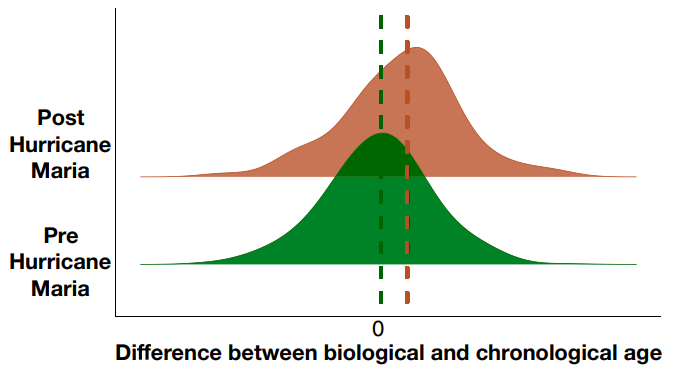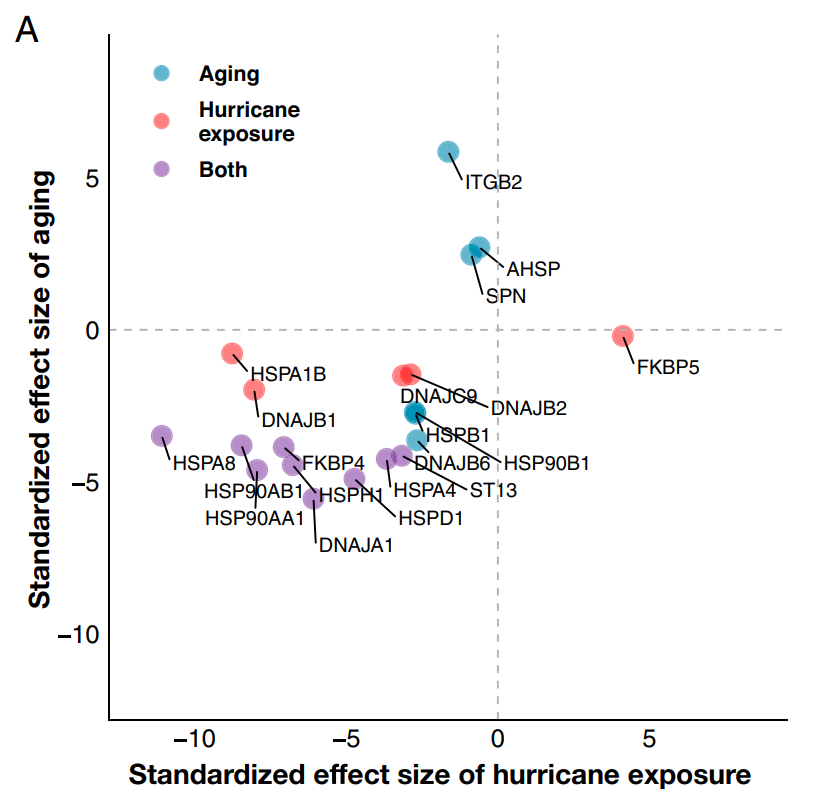Key Points:
- Adult rhesus macaque monkeys that experienced Hurricane Maria exhibited gene activity patterns indicative of accelerated biological aging by two years.
- Levels of gene activity for chaperones — proteins involved in protein folding — decreased in monkeys with natural disaster adversity.
- Immune cell composition in monkeys that lived through Hurricane Maria was similar to the immune cell composition in aged monkeys.
When people experience serious adversity, particularly a natural disaster, it can appear as if they’ve aged rapidly. New research shows that a survivor’s superficial and emotional wear and tear are might actually reflect what’s going on inside as natural disasters accelerate biological aging at the DNA level.
In a new study published in Proceedings of the National Academy of Sciences, Watowich and colleagues examined the genetics of aged individuals and rhesus macaque monkeys on the Puerto Rican island of Cayo Santiago before and after Hurricane Maria to elucidate the potential link between natural disasters and accelerated aging. They found that the genetic profiles of monkeys that experienced Hurricane Maria were on average 1.96 years older than their chronological age. Investigators also showed that monkeys who lived through Hurricane Maria displayed reduced gene activity levels responsible for protein folding and degradation. Further genetic analysis also revealed that immune cell gene activity was similar in aged individuals and monkeys exposed to Hurricane Maria. The study’s findings conclude that natural disaster adversity and accelerated aging are potentially linked to disrupted protein networks and hampered immune cell regulation.
Hurricane Maria Accelerates Biological Age
Although chronological age tells us how many years we’ve existed on this earth, molecular indicators reveal how much we have aged biologically and tell us if our bodies have experienced accelerated aging.
“While everyone ages, we don’t all age at the same rate, and our lived experiences, both negative and positive, can alter this pace of aging… But we still don’t know exactly how these events get embedded in our bodies leading to negative health effects that may not show up until decades after the event itself,” stated corresponding author Noah Snyder-Mackler in a press release.
To determine whether monkeys that lived through Hurricane Maria exhibited accelerated aging, Watowich and colleagues looked at patterns of mRNA molecules — messengers that serve as templates for protein assembly — that have been previously used as biological age predictors in humans. Notably, monkeys that experienced Hurricane Maria displayed mRNA patterns correlated with an average increase of 1.96 biological years, equivalent to seven to eight human years. Given that their biological age surpassed their chronological age, the evidence suggests that natural disaster adversity contributes to accelerated aging in rhesus macaque monkeys. However, whether these findings translate to humans requires further research.

Hurricane Maria Disrupts Protein Equilibrium
One of the hallmarks of aging is disrupted proteostasis — a regulatory network responsible for the generation, transportation, and degradation of proteins (protein homeostasis). One way to maintain proteostasis is to ensure proteins’ correct folding and orientation by chaperone proteins. Once a protein’s natural structure collapses, so does its function and thus requires degradation. Moreover, some studies show that decreased protein folding and degradation amplifies the risk of developing age-related diseases like Alzheimer’s and cardiovascular disease.
To determine if there were similarities in biological aging between the monkeys that experienced Hurricane Maria and aged individuals, Watowich and colleagues compared the gene activity of both groups. They found that the genes responsible for coding molecular chaperones were significantly decreased in both the aged individuals and the monkeys who went through Hurricane Maria. What’s more, genes involved in promoting protein degradation were dramatically reduced in both groups. These results highlight the potential role of natural disasters in driving the onset and progression of age-related conditions.

(Watowich et al., 2021 | PNAS) Genes coding for chaperone proteins are linked to aging and exposure to Hurricane Maria. The graph shows genes affected by aging (blue dots), hurricane exposure (red dots), or both (purple dots). Dots in the bottom left quadrant are genes with reduced expression. Dots in the top left and bottom-right quadrants are genes with increased expression. The chaperone proteins responsible for proteostasis begin with HSP.
Hurricane Maria Affects Immune Cell Activity
Scientists have coined the term “inflammaging” to describe the close relationship between low-grade chronic inflammation and aging. Inflammaging has been connected to a wide range of age-related disorders in various organs, particularly the brain, and researchers continue to monitor inflammatory markers to track cellular aging.
To see if natural disaster exposure was linked to inflammaging, the research team compared the immune cells of aged individuals and monkeys who experienced Hurricane Maria. Results showed that aging and exposure to Hurricane Maria were strongly associated with diminished activity levels in genes coding for anti-inflammatory molecules. Additionally, the data showed that genes linked to pro-inflammatory molecules exhibited elevated activity levels in both groups. These findings point to a mechanism through which natural disasters promote accelerated aging and premature age-related morbidity.

(Watowich et al., 2021 | PNAS) Aging and hurricane exposure are linked to increased expression of proinflammatory genes and reduced expression of anti-inflammatory genes. (A/B) Dots to the right of the dashed line indicate increased expression, and dots to the left indicate reduced expression.
What Can We Do?
Whether we like it or not, natural disasters are inevitable, and evidence suggests that these catastrophes will occur more frequently in the future. So, we must provide inflicted populations with emergency relief and treatments that improve immune health by suppressing biological contributors of accelerated aging.
“Importantly, we identify a critical mechanism — immune cell gene regulation — that may explain how adversity, specifically in the context of natural disasters, may ultimately ‘get under the skin’ to drive age-associated disease onset and progression,” concludes lead author Marina Watowich.
So, what’s available to prevent the accelerated aging seen in natural disaster survivors? One possibility is supplementing with an NAD+ precursor because decreases in NAD+ are linked to inflammaging and NAD+ precursors boost NAD+ levels. NAD+ precursors have already been shown to have beneficial effects on inflammation. So, rescuing NAD+ levels may stop the inflammaging triggered by a natural disaster in its tracks. This would be a relatively inexpensive and painless solution to helping survivors live a whole life following trauma from natural disasters.